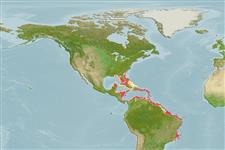Common names from other countries
Environment: milieu / climate zone / depth range / distribution range
Écologie
Récifal; profondeur 0 - 53 m (Ref. 101593). Tropical; 33°N - 24°S, 89°W - 32°W (Ref. 107482)
Distribution
Pays | Zones FAO | Écosystèmes | Occurrences | Introductions
Western Atlantic: Bermuda and Florida to Rio de Janeiro, Brazil, including Yucatan and the Caribbean Sea.
Length at first maturity / Taille / Poids / Âge
Maturity: Lm ? range ? - ? cm Max length : 31.0 cm TL mâle / non sexé; (Ref. 271); common length : 20.0 cm TL mâle / non sexé; (Ref. 4)
West Central Atlantic; Southwest Atlantic: Western Atlantic; Bermuda and Florida to E. Brazil, including Yucatan and the Caribbean Sea. 31 cm, maximum total body length; 20 cm, common length. Occurs in coastal waters down to 50 m with rock or coral substrate (Ref. 4). Minimum depth range from Ref. 122059. Inhabits coastal waters with rock or coral substrates (Ref. 4). On rubble (Ref. 97531). Requires calcareous substrate with algae and gravel (Ref. 81730). Scarce and generally found in reef habitats (Ref. 104228). Coexists with Panulirus argus (Ref. 102863) but little competition is likely to occur between the two (Ref. 104228). In general, palinurids are mainly considered carnivores, usually feeding upon sluggish, easily captured animals where most material is eaten alive or freshly killed (Ref. 105260).
Life cycle and mating behavior
Maturité | Reproduction | Frai | Œufs | Fécondité | Larves
Members of the order Decapoda are mostly gonochoric. Mating behavior: Precopulatory courtship ritual is common (through olfactory and tactile cues); usually indirect sperm transfer.
Holthuis, L.B. 1991. (Ref. 4)
Statut dans la liste rouge de l'IUCN (Ref. 130435)
statut CITES (Ref. 108899)
Not Evaluated
Not Evaluated
Utilisations par l'homme
Pêcheries: commercial
| FishSource |
Outils
Plus d'informations
Taille/ÂgeCroissanceLongueur-poidsLongueur-longueurMorphologieLarvesAbondance
Sources Internet
Estimates based on models
Preferred temperature
(Ref.
115969): 25.4 - 28.1, mean 27.4 (based on 136 cells).
Vulnérabilité
Low vulnerability (21 of 100).
